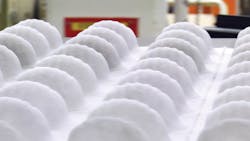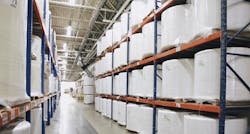At the beginning of this year, Siddhi Salvi and the Cummins Filtration product team spent virtually all of their time working on new ways to refine the company’s Fleetguard fuel, lube, and air filtration media for diesel engines. Their main challenges were coaxing ever-better filter efficiency, capacity, and flow restriction to capture contaminants and extend the lives of commercial trucks and off-highway equipment.
Then came COVID-19.
“We had been researching various applications beyond the engine filtration industry where our media could be utilized,” said Salvi, the product manager for media at Cummins Filtration in Nashville. The filtration capabilities of NanoNet media technology, the same multilayered polymeric synthetic media used in the company’s most advanced engine filters, suggest that the material would also be effective for N95 respirators, the most common type of face mask for healthcare workers.
When NanoNet was tested using industry-standard methods, it exceeded the performance requirements implied by the N95 designation, which includes not only the mask material but other aspects like fit. Companies that incorporate the media would need to seek approval from the National Institute for Occupational Safety and Health (NIOSH) to list their products for sale with NIOSH’s N95 designation.
For Salvi and the product team, the question was always whether there would be sufficient demand and urgency to move ahead with the research and development necessary to supply NanoNet for use in N95 masks.
The pandemic provided an answer.
The need for N95 respirators has been overwhelming. In March, the U.S. Department of Health and Human Services estimated that healthcare workers alone will require 3.5 billion N95 masks during the outbreak. The agency has ordered 600 million N95 masks from five companies to distribute to hospitals and replenish the national stockpile.
“We looked at the situation and knew we could help,” said Salvi. “We have a high-performance media, global production capacity, great partners, and a lot of creative energy to channel into supporting this global effort to help manufacturers supply more masks. We wanted to get to work.”
Popular PPE
Cummins Filtration is one of several heavy-duty equipment manufacturers that have mobilized resources to support the production of personal protective equipment (PPE) and other supplies to help fight against the coronavirus.
N95 respirators are the PPE most often used to control exposure to COVID-19 and other infectious diseases transmitted through the air. The N95 designation means the masks can block at least 95 percent of particles from entering the wearer’s nose and mouth. They’re designed to filter out a wide range of different contaminants down to 0.3 micron in size or smaller, including airborne viruses spread from person to person when someone coughs, sneezes, or talks.
The company has provided samples of NanoNet to mask manufacturers across the globe for testing, and it’s also supporting a unique collaboration with researchers at the University of Minnesota.
The group is developing a respirator with protection similar to N95-level effectiveness that can be mass-produced using materials that aren’t likely to be affected by supply chain shortages. It includes students and faculty from the university’s Institute for Engineering in Medicine; Medical School; College of Design; College of Science and Engineering; and Center for Filtration Research Consortium (CFR).
Using NanoNet media donated by Cummins, the team has designed two respirator-mask prototypes—one modified anesthesia mask and one single-use mask.
In an ideal world, wearers in healthcare would get an N95 and change it between every patient. But in practice, the project team found, masks and other PPP may be rationed or reused multiple times. The University of Minnesota’s designs are meant to be effective, durable, comfortable, simple to produce, and provide relief when stocks of N95 masks run low.
Material Advantages
Within 12 hours after receiving the NanoNet material, the team at the University of Minnesota tested it and determined it would provide wearers of the prototypes with N95-level protection.
“The first thing we recognized from our experts in the Center for Filtration Research, who work directly with Cummins, is that not all filtration materials are created equal,” said Jakub Tolar, campus health officer and medical school dean at the University of Minnesota.
NanoNet is a fully polymeric material made of sub-micron-sized fibers bonded together in various layers. The synthetic fibers don’t shift and come apart under dynamic conditions, which preserves their ability to capture particles as small as 0.2 microns.
As a material for respirators, NanoNet has two other important advantages.
It incorporates Dupont technology that helps enhance the breathability of the material while maintaining a high filtration efficiency of particulates.
Durability is another factor. NanoNet is designed to be tightly pleated, placed in a filter housing, and then work over thousands of miles of use to prevent tiny pieces of metal, dirt, and other contaminants from circulating through a heavy-duty engine. The material is resilient and retains its filtration qualities after it’s been processed and formed into shape by the mask manufacturer, Salvi said.
The next steps for the University of Minnesota team are to define ways to produce the masks quickly and cost-effectively and then to manufacture a limited run for Minneapolis-based healthcare systems.
Ultimately, the project will publish open-source instructions that other healthcare systems and groups can use to make their own masks.
PAPR Production
Cummins Filtration is also manufacturing high-efficiency particulate filters for use in 3M’s Powered Air Purifying Respirators.
Powered air-purifying respirators (PAPRs) are an important piece of equipment for front-line healthcare workers responding to the COVID-19 pandemic. PAPRs use a battery-powered blower that sends filtered air into a hood or head top that covers the wearer’s head or face; and can provide increased levels of respiratory protection, especially for critical healthcare situations such as aerosol-generating procedures.
PAPRs may also be more comfortable to wear for those who need respiratory protection for long periods of time.
Cummins Filtration is using its existing manpower and equipment at its Neillsville, Wisconsin, facility to pleat the media, assemble it into cartridge housings, and do final testing before shipping the filters to Valley, Nebraska, where 3M’s PAPRs are manufactured.
The partnership has the potential to more than double the current production of filters for 3M’s PAPRs. The additional filters are needed as 3M has ramped up the production of PAPRs to meet a surge in demand for personal protective equipment due to the COVID-19 outbreak.
Satisfying Work
With the need for N95 respirators and other types of PPE continuing to grow, Salvi is proud of the company’s role among manufacturers and the University of Minnesota team to find innovative ways to relieve the burden.
“Our team has a long history of success with high-performance filter media for trucking and other heavy-equipment applications,” she said. “It’s especially gratifying to use our resources and expertise to help protect people, too.”
How Low Can You Go? Filtering Small Particles is a Balancing Act
Like the droplets containing COVID-19, the size of contaminants in fuel, oil, and air moving through a diesel engine is measured in microns.
A micron is a unit of length equal to 1 millionth of a meter or 39 millionths of an inch. For context, a human hair is 50 to 70 microns in diameter. Dust, sediment, and other types of hard particles that can wear down engine components are typically in the 5- to 15-micron range or less.
Filter designers want to stop these tiny contaminants but they have to balance three things: the filter’s efficiency, or the size of the particles it can capture; its capacity to hold contaminants during the filter’s service life; and the flow restriction that naturally increases as the filter collects more unwanted contaminants.
The challenge is to remove small particles at the highest efficiency. But it’s not possible to simultaneously improve efficiency, capacity, and flow restriction using traditional media.
In response, Cummins Filtration created a new type of synthetic media that allows filter performance to progress past many of the tradeoffs that traditional media present. The company introduced NanoNet for Fleetguard fuel filters in 2012 and developed a variant for lube filter applications beginning with the LF14000NN used in Cummins heavy-duty engines.
NanoNet media is comprised of five layers of thin, tightly woven polymer fiber in a mesh material no thicker than a dime. In a heavy-duty filter application, it can capture particles as small as 4 microns 99.9% of the time. That means of 100,000 particles flowing into the filter, only 100 would make it through the media. NanoNet is capable of capturing particles as small as 0.2 microns.
Tougher emissions standards have led to engines that require extremely clean fuel, air, and lubricants. Synthetic, multilayered filtration media like NanoNet is a big step forward in terms of being able to remove the smallest contaminants while retaining very high efficiency and capacity. The result is better performance, less risk of unplanned downtime, and the service life you expect from your engine.


